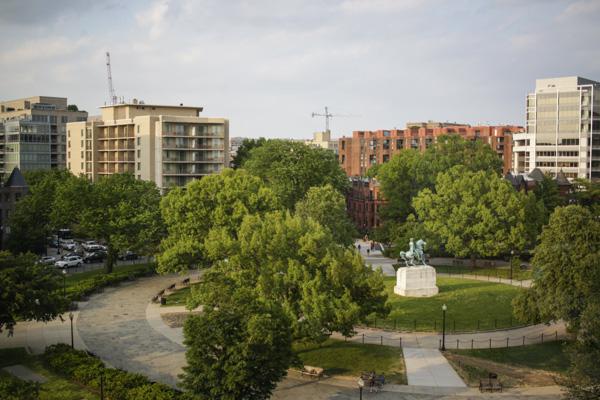Community members and the District Department of Transportation officials will meet June 15 to officially launch a study on Foggy Bottom transportation.
The Downtown West Transportation Planning Study began in April and will continue over the next year. City officials will use the study’s results to improve congested transportation patterns for cyclists, pedestrians and buses near campus.
The study covers two areas near campus: Pennsylvania Avenue, between 17th Street and Washington Circle, and H and I streets between New York Avenue and Pennsylvania Avenue, according to a DDOT press release.
The study will assess bike transportation patterns and determine the feasibility of adding separate bike lanes in the area. Pennsylvania Avenue, particularly between Washington Circle and 17th Street, was identified as a “major cycling route” by D.C.’s current long-term transportation plan, moveDC, in a 2013 bus improvement technical report.
Transportation officials will consider adding a bus lane on H Street between New York and Pennsylvania avenues, which would allow buses to travel in a separate lane against the current flow of traffic on that street.
Staff from the department of transportation will consider traffic patterns in the area and community input as part of the study.
Peter Sacco, the executive director of the Foggy Bottom Advisory Neighborhood Commission, said neighbors have discussed Washington Circle’s traffic flow since he was the Foggy Bottom commissioner two years ago.
“I think there’s been a conversation for a while now,” he said. “I wouldn’t say it was a major issue, but it is something we’ve been paying attention to.”
Terry Owens, the director of communications for DDOT, said in an email that DDOT planned to study transportation in this area based on recommendations from moveDC officials and a 2013 study on bus transportation conducted by the Washington Metropolitan Area Transportation Authority and DDOT.
Owens said the staff who conduct the study plan to improve the urban design in the area, from the roads to the front of buildings along Pennsylvania Avenue and provide a uniform “look and feel” in the area.
“This presents the potential opportunity for additional green space, which can include active management of storm water, also known as green infrastructure,” Owens said.
Owens said funding for future design and construction is not currently in the D.C. budget.
The Golden Triangle Business Improvement District, an organization that works to improve business life for the area around campus, began work on a plan to increase sidewalk space and add a bike lane between the White House and Washington Circle in 2015. The group hired the architecture firm KGP Design Studio last year to construct a revamped Pennsylvania Avenue and develop a budget for the designs.
ANC Chairman Patrick Kennedy said he and others in the neighborhood organization support alternative transportation options in the Washington Circle area and in Foggy Bottom because of heavy traffic.
“A lot of students bicycle around, so I think it’s important that they have the space to accommodate that,” he said. “We need to make sure the cyclists feel safe, and that means having their own space on the road so they won’t be run over by the cars.”
Kennedy said some people trace the beginning of traffic issues in D.C. to when the District closed down the street in front of the White House. The Secret Service closed the block of the street to vehicular traffic after the Oklahoma City bombings in 1995.
“East-west transportation in the District has been a disaster for easily 25 years, at least,” Kennedy said.
Robin Eberhardt contributed reporting.








